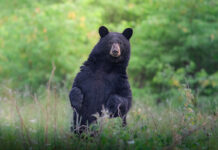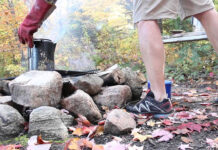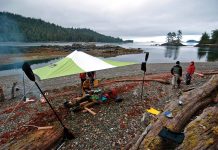As my wife and kids know all too well, I’ve got a complicated set of rules for how I expect people to behave in the backcountry. They’ve joked if I wrote my rules down, they would fill a book. It’s not a bad idea. Then if we invite anyone to join us—although, for some reason, this rarely happens—I can assign them some required reading beforehand. Here’s what I’d want them to know.
Social distancing
Social distancing has been a part of my wilderness etiquette forever. We go on paddling trips to get away from people. When encountering another group, acknowledgment of the mutual awareness of each others’ presence with a polite nod or a wave is appropriate. Do not ignore, but do not approach. Remain aloof. On a portage trail, exchange pleasantries. Comparing maps and sharing route information is allowed. Never deviate from the route or linger near someone else’s campsite to make idle chit chat. Groups ahead of us must be overtaken. Yes Dear, it is a race.
Campsite etiquette
Do not visit, walk through, camp on or near an occupied campsite. You should not pass close enough to a person’s campsite to see anything should they happen to be naked (skinny-dipping is an essential part of the wilderness experience). Wave politely and pretend to look away. Once or twice, when I was packing up to leave my campsite, someone else landed and started unloading their stuff. The horror! Just because we sometimes have to share nature with other people doesn’t mean we can’t all work together to maintain the illusion we don’t.
Packing
Travel light. No towels, you can air dry. No cotton. No pillows. The group must share one tube of toothpaste. Always bring and wear as few clothes as possible. However, if you don’t have at least one more layer to put on if it gets colder, you didn’t pack enough. If you end the trip with one layer you never wore, you packed too much.
Pack up your bedding in the morning before leaving the tent for a swim. Yes, the morning swim is mandatory. Put your paddling clothes on when you wake up if it’s a traveling day. Fit all your clothes in one stuff sack. Don’t leave clothes lying around.
Pack heavy pots on the bottom of the food pack. Marshmallows (two per serving), crackers and fruit go on top. Food should be nutritious. Yes to coffee and yes to chocolate but no juice crystals. No Pop-Tarts. Distribute weight evenly, side to side and bow to stern; never mind, loading the boat is my job. Always portage with as few trips as possible.
Campsite furniture
Here is a small miracle: whenever stringing up a clothesline or hanging up your gravity water filter, look up at the nearest tree and you’ll find a convenient nail! How does this happen? Who travels the wilderness with a hammer and nails? Not anyone I know. You nail people are troglodytes. And I think you left some garbage in the fire pit, too. Only build kitchen tables on the coast, where milled lumber occurs naturally. A kitchen table without nails, built on the beach with the lumber you find there, qualifies as no-trace camping. Storms will wash it away.
There shouldn’t be furniture on inland campsites, except government-issue picnic tables—and logs for sitting around the fire pit. And while we’re on the subject of beaches, we only camp on sand if there are no alternatives.
Paddling technique
Paddle in sync with your partner. Only open your mouth to talk if you can paddle at the same time. I’m looking at you, kids. If you’re in a canoe, no switching sides to steer unless you’re a marathon racer. Use the J-stroke, with the proper wrist-injuring technique, grip thumb pointing down. Unless you’re in whitewater, then you can do it the easy way and call it the river J. Never rub the gunwales with the paddle shaft (unless in whitewater—see river J).
Paddling a solo canoe with a two-bladed paddle is more efficient, but don’t do it. That’s not canoeing. It’s the same as a single-bladed paddling of a kayak if that’s even a thing (I hope not). No motors are allowed, obviously, except for the car, the water taxi and the floatplane—whatever mode of transport you use to get to the wilderness. But beyond that, no motors. If I see you paddling properly, wearing the right sort of clothes, and without a motor, I may be inclined to paddle a little bit closer, just a bit, and say hello.
“Going to the bathroom”
It is okay to poo beside the water below the high-tide line. But only in saltwater. And only in remote areas. In busy areas and freshwater areas, bury it deep in the forest. Far from the water. Under mineral soil. Burying toilet paper is okay. Don’t pack it out; this isn’t the Grand Canyon. Burn it, sure, as long as it actually burns.
Contrary to what some people believe, toilet paper is not like a Christmas decoration.
Contrary to what some people believe, toilet paper is not like a Christmas decoration, to be strung amongst the trees. If there is any evidence that anybody, ever, has relieved themselves on my campsite, I don’t want to camp there. Unless there is a toilet.
Protecting the water
Do not spill little bits of oatmeal into the lake, thinking they will disappear; they won’t. Do not get dish soap in the lake. It’s irresponsible to lather up on land and jump into the lake. The ocean is different. Almost anything goes. You can use soap in the ocean, but you don’t need to. Wash dishes straight in cold seawater, right on the beach. Scrub them with sand, just like I do my bum—no toilet paper required—but in a different location, please. Food scraps and everything else will wash away and be eaten by crabs. I love the ocean. The ocean is a wilderness garburator, but don’t throw garbage in it.
Breaking the rules
Wilderness is supposed to be wild—inherently anti-law, anti-civilization, anti-order, a land of chaos and disorder. If it weren’t okay to break the rules in the wilderness once in a while, then it wouldn’t be wilderness, would it? Just don’t break my rules. Unless you’re me.
If you want to break a rule, ask first what the actual intent and purpose of the rule is, and if you can live with the consequences of not just breaking it, but of everybody breaking it. Most importantly, make sure you follow the rules in place to preserve the illusion of a rule-free experience for the person who comes after you. It’s not a free country, but if we work together, we can make it feel like one.
Tim Shuff is the former editor of Adventure Kayak magazine.
This article was first published in Paddling Magazine Issue 62. Subscribe to Paddling Magazine’s print and digital editions here, or browse the archives here.
Cheers to a perfect weekend… or wilderness boot camp. | Photo: Caleb Gringas









Very well said. I think we could canoe trip together if you don’t break the rules.
Great article! Entertaining and informative. I think I’ll start writing my own set of rules. Thanks!
All great rules, except for paddling solo with a double-blade. Don’t tell me what to do. You’re not the boss of me. Otherwise, great rules. 🙂